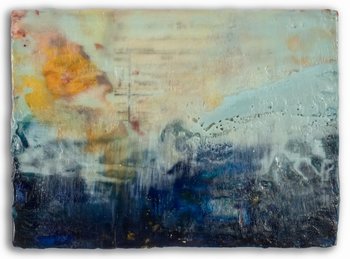In the 1920’s, the phrase "the bee's knees,” meant "the height of excellence." That’s how I feel about encaustic art. I love that encaustic painting is an organic art form, and beauty can be created with natural substances. Encaustic medium is made by blending bees wax and Damar resin, two substances found in nature. Damar resin is crystallized sap of a family of trees in the east Indies. The resin is harvested without harming the trees by slashing their trunks and collecting the sticky sap that oozes out, similar to gathering sap for maple syrup. The result is an ancient medium used for fine art.
No other art form provides this kind of translucency, almost a mysterious quality — a sense of physical depth and distance in time — to the final product.
No other art form provides this kind of translucency, almost a mysterious quality — a sense of physical depth and distance in time — to the final product.
 Sunrise Over the Mountains by Valerie Long
Sunrise Over the Mountains by Valerie Long This piece to the right is reminiscent of the mountains in Alaska I visited several years ago. Notice the depth and distance I am able to achieve with encaustic paints. Building layers and layers of pigmented encaustic wax allows me to create texture and and mystery in encaustic art. In the background of this painting I am able to embed a document that is personal to me, which is printed on Japanese Kozo paper.
In its simplest form, encaustic paint is melted wax, damar resin, with added pigments for color. The artist brushes the hot paint onto a porous surface such as a wooden board treated with gesso, than adds more wax layer by layer, reheating each layer to fuse it to the surface beneath. If a work is not fused, the layers will not adhere to each other.
Encaustic paint techniques go back 2,500 years. Starting around the fifth century B.C., encaustic was one of the favorite media of the Greek and Roman world. When the Roman historian Pliny the Elder made a list of notable encaustic painters for his Natural History A.D. 77-79, he included Greek artists from 600 years before his own time. Pliny called painting with wax “encaustica,” and he quoted the Greek word from which the Latin sprang - meaning to burn in. He linked encaustics’ beginnings to shipwrights who would paint the sides of their wooden warships with wax to help make their ships watertight.
Thanks to wax’s durability and imperviousness to moisture, encaustic paintings from Pliny’s time and the following 200 years have survived with their delicate detailmulticultural community that combined Egyptian burial practices with Greek and vivid colors intact. The Fayum oasis in Roman-ruled Egypt boasted a artistic styles. Artists painted portraits on wooden panels that were then set into the pictured person’s wooden coffin or the linen wrappings of his or her mummy.
Beginning in the 19th century, archaeologists and looters unearthed about 1,000 of these portraits. Most of the museums in Egypt, Europe, New York and California. If you are able to travel to any of these museums, check out ancient (and even recent) examples of encaustic art. You’ll be love the quality, translucency, and mystery of encaustic art. It really is the “bee’s knees.”
In its simplest form, encaustic paint is melted wax, damar resin, with added pigments for color. The artist brushes the hot paint onto a porous surface such as a wooden board treated with gesso, than adds more wax layer by layer, reheating each layer to fuse it to the surface beneath. If a work is not fused, the layers will not adhere to each other.
Encaustic paint techniques go back 2,500 years. Starting around the fifth century B.C., encaustic was one of the favorite media of the Greek and Roman world. When the Roman historian Pliny the Elder made a list of notable encaustic painters for his Natural History A.D. 77-79, he included Greek artists from 600 years before his own time. Pliny called painting with wax “encaustica,” and he quoted the Greek word from which the Latin sprang - meaning to burn in. He linked encaustics’ beginnings to shipwrights who would paint the sides of their wooden warships with wax to help make their ships watertight.
Thanks to wax’s durability and imperviousness to moisture, encaustic paintings from Pliny’s time and the following 200 years have survived with their delicate detailmulticultural community that combined Egyptian burial practices with Greek and vivid colors intact. The Fayum oasis in Roman-ruled Egypt boasted a artistic styles. Artists painted portraits on wooden panels that were then set into the pictured person’s wooden coffin or the linen wrappings of his or her mummy.
Beginning in the 19th century, archaeologists and looters unearthed about 1,000 of these portraits. Most of the museums in Egypt, Europe, New York and California. If you are able to travel to any of these museums, check out ancient (and even recent) examples of encaustic art. You’ll be love the quality, translucency, and mystery of encaustic art. It really is the “bee’s knees.”
 RSS Feed
RSS Feed